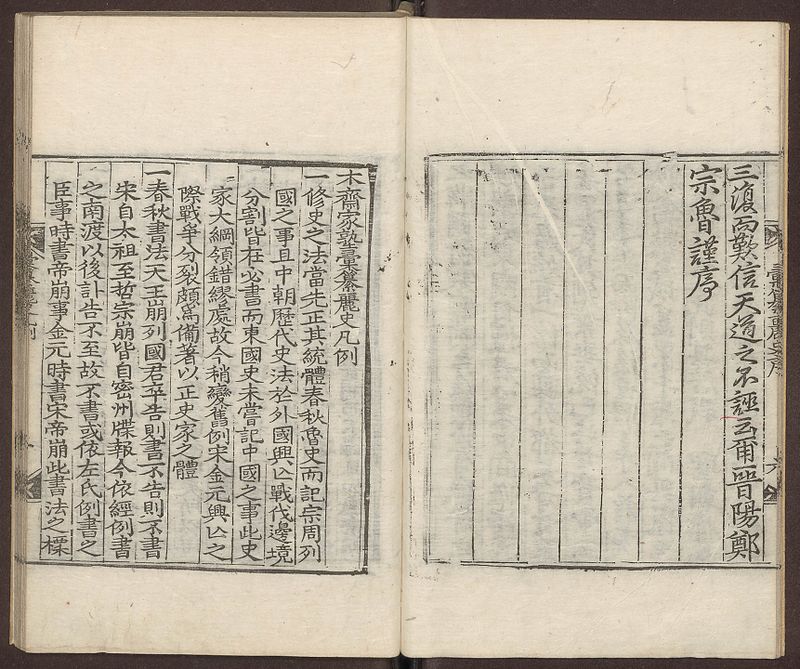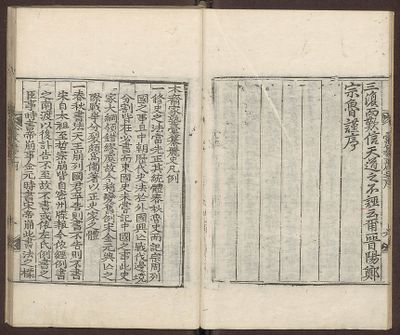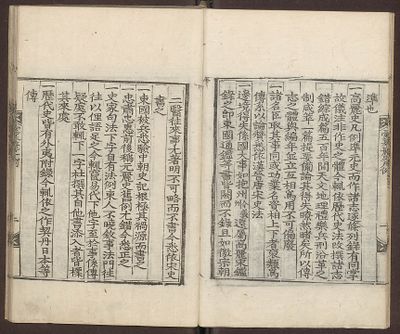(Translation) 彙纂麗史 凡例
| Primary Document | ||
|---|---|---|
 |
Title | |
| English | Explanatory Notes on the Compiled Edition of Koryŏ History | |
| Chinese | 彙纂麗史 凡例 | |
| Korean(RR) | 목재가숙 휘찬려사(Hwichʻan yŏsa) 범례 | |
| Text Details | ||
| Genre | History book | |
| Type | ||
| Author(s) | 洪汝河 | |
| Year | mid-17th century | |
| Key Concepts | historiography, Koryŏ history, international relations | |
| Translation Info | ||
| Translator(s) | Participants of 2018 Summer Hanmun Workshop (Advanced Translation Group) | |
| Editor(s) | King Kwong Wong | |
| Year | 2018 | |
Introduction
Original Script
| Image | Text | Translation |
|---|---|---|

|
彙纂麗史 凡例
一。春秋書法,天王崩,列國君卒,告則書,不告則不書。宋自太祖至哲宗崩,皆自密州牒報,今依經例書之。南渡以後,訃告不至,故不書,或依左氏例書之。臣事時,書帝崩。事金元時,書宋帝崩。此書法之標 |
Explanatory Notes of the Compiled Edition of Koryŏ History
- According to the historiographical principle of the Spring and Autumn [Annals], [the death of] the heavenly sovereign is written as demise, and the [death of] various state rulers is written as decease. Whenever [the obituary] was received, it is recorded; whenever it was not, then it is not recorded. During the Song from Taizu to Zhezong, the obituary of the emperor all came from the government reports dispatched from Mizhou.[1] After [the Song] moved south, the obituary did not reach [the Eastern state], therefore it is not recorded, or following the example of Mister Zuo,[2] it is recorded. When [the Eastern state] submitted and served [the Song], [the death of] the emperor is recorded as “the emperor demised.” When [the Eastern state] served the Jin and Yuan, [the Song emperor’s death] is recorded as “the Song emperor demised.” This is the standard of historical principle. |

|
準也。 一。高麗史凡例,準元史而作諸志,逐條列錄,有同掌故議注,非作史之體。今輒依歷代史法,改撰諸志,錯綜成編。五百年間天文,地理,禮樂,兵刑,沿革之制,咸萃一篇,提要備論,其得失,瞭然睹矣。所以傳志之體,與編年並立,互相爲用,不可偏廢。 一。諸名臣,取其事同或功業名資相上下者,裒類爲傳,糸以論贊。悉依漢,晉,唐,宋史法。 一。邊境得失,係國大事。如抱州今義州,還屬高麗,宋鑑錄之。卽東國通鑑等書,皆闕而不錄。且如徽宗朝二醫往來事,尤著明,不可略而不書。今悉依宋史書之。 一。東國被兵,悉驗中朝史記,根極其禍源而書之。 一。忠肅,忠惠前後稱元,麗史舊例尤錯。今悉正之。 一。史家句法,下字自有法例。東人不曉,敍事法門,往往以俚語足之。今輒竄易,代下他字。至於事係傳疑處,不敢輒下一字杜撰。其自他書添入者,皆標其來處。 一。歷代史,皆有外夷附錄。今輒依之,作契丹,日本等傳。 |
- As to the style and format of the History of Koryŏ, they follow the standard of the History of Yuan for the writing of various treatises. One by one each entry is listed and recorded; this is not the standard of writing history. Now I imprudently follow the historiographical principle of previous dynasties, alter the composition of various treatises, synthesize the entries into proses. The evolution of the institution of astronomy, geography, military affairs and punishments during the 500 years all are assembled into proses, so that their summary and entire discourse, as well as advantages and disadvantages, will be observed clear-sightedly. Therefore, the form of biographies and treatises should be established together with the that of chronicle; each makes use of the other. One should not emphasize one form at the expense of another. - As to the various prominent ministers, take those who had the same affairs or those who had high and low achievements, reputations, and backgrounds, compile them into biographies, and attach to them my commentary. All follow the historiographical principles of [the Book of] Han, [the Book of] Jin, [the Book of] Tang, and [the History of] Song.[3] - The gain and loss of borderland is an important affair that binds the state. For example, P'oju (RR: Poju) now Ŭiju (RR: Uiju), which was returned to Koryŏ, the Mirror of the Song[4] records it. Even the Comprehensive Mirror of the Eastern State[5] and the others, all leave out and does not record it. Other examples, such as the two physicians travelled [between Koryŏ and Song] during the reign of Huizong (r. 1100-1126), were particularly illuminating that cannot be left out and not written. Now following the History of Song all are written. - As to the wars waged on the Eastern state, all are examined from the historical records of the central court, tracing the roots of such calamity and record them. - As to the first years of Ch’ungsuk’s and Ch’unghye’s second accession are written as “First Year”; the old format of the History of Koryŏ is particularly wrong. Now all are amended. - - As to the histories of previous dynasties, all have appendixes on foreign barbarians. Now I imprudently follow them and write Kitan, Japan and other biographies. |

|
一。中朝兩漢,晉南北朝,唐,宋修史,皆以紀傳爲重。如通鑑綱目,非史官所作,卽諸史紀傳,檃栝而就,故其文燁然可觀。東國雖有列傳,其文俗而不典。東國通鑑等書文,第因之。所以不逮中國史之爾雅也。茲取列傳,略加删潤,事增於舊十之一,文省於前十之六,以俟秉筆者,掇入於編年策書。勒成東國之大典焉。 |
(translation) |
- Discussion Questions:
Further Readings
- ↑ nowadays in Shandong province, China
- ↑ refers to Zuo Qiuming, the author of the Zuo Commentary
- ↑ The Book of Han 漢書 was written by Ban Gu 班固 (32-92 CE) and completed by Ban Zhao 班昭 (45?-116? CE) during the Eastern Han period (25-220 CE). The Book of Jin 晉書 was compiled by Fang Xuanling 房玄齡 (579-648 CE) in 648. There are two books of Tang – the Old Book of Tang 舊唐書 and the New Book of Tang 新唐書. The Old Book of Tang was compiled by Liu Xu 劉昫 (888–947 CE) in 945 and the New Book of Tang was compiled by Ouyang Xiu 歐陽修 (1007-1072 CE) in 1060. The History of Song was compiled by Toqto'a 脫脫 (1314-1356 CE) in 1345.
- ↑ Its alternative title is 增修附註通鑑節要續編. It was compiled by Liu Shan 劉剡 and edited by Zhang Guangqi 張光啓 during Ming Xuanzong’s reign (1426-1435).
- ↑ It was compiled by Sŏ Kŏchŏng 徐居正 (RR: Seo Geojeong, 1420-1492) and completed in 1485.